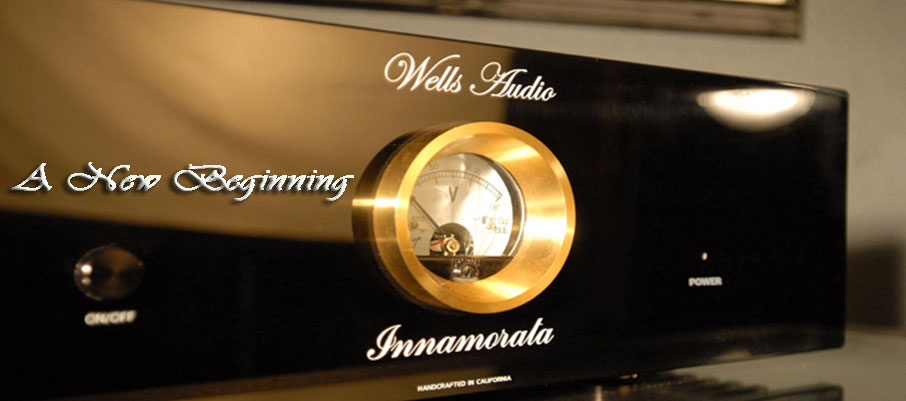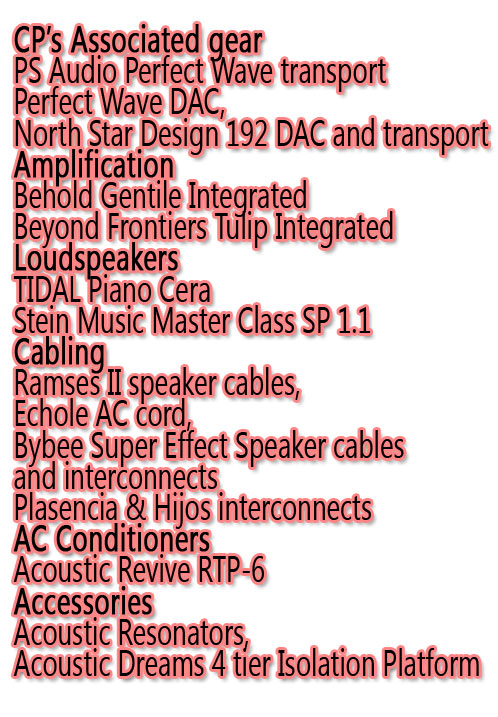Wells Audio Innamorata Stereo amplifier


A New Beginning
 Wells Audio manufactures an exciting new pair of amplifiers named for Jeff Wells, a passionate high-end audio retailer located in Campbell, CA, whom I’ve known for more than a decade. When Wells first launched the Akasha and Innamorata stereo amplifiers, they received a flood of high praise. If you read Greg Simmons’ insightful review (here), then you know how smitten he was by the Akasha’s performance—especially in light of its price tag ($4,000). Greg’s impressions were pretty much duplicated wherever the Akasha happened to be auditioned. Its tube-like harmonic richness, top-end clarity and vice-like grip on the lower extremes were quite a winning combination.
Wells Audio manufactures an exciting new pair of amplifiers named for Jeff Wells, a passionate high-end audio retailer located in Campbell, CA, whom I’ve known for more than a decade. When Wells first launched the Akasha and Innamorata stereo amplifiers, they received a flood of high praise. If you read Greg Simmons’ insightful review (here), then you know how smitten he was by the Akasha’s performance—especially in light of its price tag ($4,000). Greg’s impressions were pretty much duplicated wherever the Akasha happened to be auditioned. Its tube-like harmonic richness, top-end clarity and vice-like grip on the lower extremes were quite a winning combination.
Wells says his Akasha will compete with amplifiers costing many times its asking price. And the Innamorata, he says, will compete against any amplifier, regardless of price, prestige or performance specs. This may sound marketing hype, but Wells speaks with such sincerity, you get the impression its coming from every inch of his being—all 6’7″ of it! Of course, I haven’t met a manufacturer who hasn’t felt exactly the same way about his or her product. A designer who has put in months or years of hard work to produce a product of which he is proud is fully justified in enthusiastically voicing that pride. It’s only human for audio designers to dream of attaining the revered plateau of the likes of Nelson Pass, Conrad Johnson and Mark Levinson.
Wells Audio is built on tried and true, old school design goals. Beneath the Innamorata’s attractive exterior is a straightforward, dual-mono, class A/B amplifier employing six Toshiba output transistors per side—nothing groundbreaking or tour de force in terms of specifications. Wells constantly stressed that “…the real magic to the Innamorata isn’t its sophisticated parts as much as its performance. Listen closely and then you tell me.” But he does give credit to the Bybee Purifiers and Music Rails he included in the Innamorata’s circuit design.
Both Jeff and I are huge fans of Jack Bybee’s products. I have had no personal experience with Music Rails although I did write at length about an enlightening blind A/B listening session at CES2011 that included a Wells prototype with Music Rails. Music Rails are rather like miniature power conditioners. They contain electronic modules built on small circuit boards that measurably reduce all types of noise on power supply rails. They have a low noise-floor and low impedance and deliver highly purified DC power. The noise that’s filtered from the electron stream is delivered to AC ground. Voltage drop is 0.5V for any load up to 2A, and 2.l V for any load up to 15A.
In addition to Music Rails, a pair of Bybee Purifiers are situated at the AC input of the Innamorata. Purifiers remove what is known as 1/f noise. 1/f is a quantum noise resulting from the interaction between electrons and the crystal lattice structure of the conductor. It is limited to frequencies between DC and 2000 Hz and it impacts low-level signal purity. I have been using Bybee Purifiers in my big rig for many years. Their effect on improving the speed, clarity and articulation of my Sunny Majestic’s 18″ woofers is little short of breathtaking. Needless to say, I was looking forward to hearing the Innamorata in the rather close confines of my downstairs listening room.
The Innamorata is neither small nor lightweight, as you might expect of a linear power-supplied amplifier rated at 120 watts per channel. Lifting it from its shipping box was reminiscent of the old days when amplifiers were real heavy weights. No class D, or T or Z here!

For the front panel Wells chose a brass-ringed voltmeter. I love the way it looks against the white scripted lettering, though I honestly would have much preferred if it swung to the musical output rather than just sitting at the incoming voltage. I also would have liked it if the meter came with an internal light. The rear panel has an IEC connector, a pair of 5-way WBT binding posts and a pair of RCA inputs. It is a genuinely good-looking product and appears well built, although sparse in terms of available inputs and outputs. The addition of a mono switch would improve flexibility, enabling the Innamorata to serve as a monoblock considering one’s desire and/or budget .
Getting Nostalgic
If you read my review of the Burson Audio Timekeeper, you know how much I liked its excellent dynamics, dexterity, vibrancy and its high octane musicality. I mentioned how the Timekeeper took me back to my early years when the fabulous Mark Levinson ML23 amplifier served as my reference. The Innamorata, on the other hand, boasts a certain textural liquidity and purity that is very similar to another of my all-time favorite amplifiers: the Pass Labs Aleph Zero monoblocks. But the Innamorata appears far more full of zest and powerful on the extremes, and that allows it to flourish with a bevy of different (read: difficult to drive) loudspeakers. The Alexis Sound Rebecca monitors seemed to relish the energy-charged dynamic swings offered by the Innamorata, while even the TIDAL Piano Ceras appeared more sanguine and attentive in its demeanor, as if the Innamorata lit a fire under its behind.
 Enjoying the benefits of vinyl of late (compliments of the Origin Live Resolution Mk III,) I’ve been repeatedly stupefied by Harry Belafonte’s performance of “In the Evenin’ Mama”, from the Living Stereo reissue of Belafonte Sings the Blues. Belafonte’s voice seemed to flow effortlessly between the loudspeakers and the front wall, with perhaps a tad more of presence with the Timekeeper. His voice wasn’t more forward so much as more fleshed out, palpable and perhaps, more resolute. I was surprised by how closely related the Innamorata and Timekeeper sound to each other. The overall musicality and PRaT made it difficult to sit still and listen without bobbing my head and tapping my feet.
Enjoying the benefits of vinyl of late (compliments of the Origin Live Resolution Mk III,) I’ve been repeatedly stupefied by Harry Belafonte’s performance of “In the Evenin’ Mama”, from the Living Stereo reissue of Belafonte Sings the Blues. Belafonte’s voice seemed to flow effortlessly between the loudspeakers and the front wall, with perhaps a tad more of presence with the Timekeeper. His voice wasn’t more forward so much as more fleshed out, palpable and perhaps, more resolute. I was surprised by how closely related the Innamorata and Timekeeper sound to each other. The overall musicality and PRaT made it difficult to sit still and listen without bobbing my head and tapping my feet.
 No matter the source, the Innamorata’s ebb and flow on certain recordings was hauntingly slow. Nothing quite illustrates the ‘drama of tempo’ and ‘sustained intensity’ like Shirley Horn when backed by an orchestra! Listening to Summer (Estaté), from her Here’s to Life CD, perhaps my favorite song on this classic recording, had me just smiling at this diva’s vocal phrasings, timing and her innate ability to draw you into her world.
No matter the source, the Innamorata’s ebb and flow on certain recordings was hauntingly slow. Nothing quite illustrates the ‘drama of tempo’ and ‘sustained intensity’ like Shirley Horn when backed by an orchestra! Listening to Summer (Estaté), from her Here’s to Life CD, perhaps my favorite song on this classic recording, had me just smiling at this diva’s vocal phrasings, timing and her innate ability to draw you into her world.
It’s one thing when a recording purposely takes you on a slow ride, but when a component gets out of the way and allows this to occur, then you know you have arrived. It may be a purely subjective consequence of a lowered noise floor, improved richness and tonal/timbral accuracy, however it certainly gives one the sense of almost being in a state of suspended animation where only the music is playing. Not the equipment. To me, this offers hints into the Innamorata’s sonic capabilities because the only product that consistently provides that feat outside of a vinyl rig is the latest updated Laufer Teknik Memory Player. That the Innamorata can imitate this feat with the PS Audio Perfect Wave transport/DAC combo tells you how far not-too-overpriced high-end products have come.
In Summary
After lengthy listening, it seemed to me the Innamorata produces less distortion at the frequency extremes, giving the music just a bit more glow and richness. That the Timekeeper sounds rather like the Innamorata tells you something about its excellence as well, especially considering its cost ($2,600). One difference between them, as I listened more intimately, was the Innamorata’s organic sense of capturing space. Everything sounded connected to everything else, without crowding or smearing; hard to describe, but easy to hear, especially when playing my favorite vinyl recordings. In the areas of space/density, pitch/articulation and resolution/harmonic-integrity I found the Innamorata more compelling.
I have been living with Bybee products for such a long time, most of what I heard was not necessarily earth shattering, because I already knew what to expect. However, all my Bybees were acquired through separate purchases of an AC conditioner, Speaker and RCA Bullets. That being said, for a stand alone amplifier to have this quality of Bybees already incorporated into it is absolutely mind boggling at this price. I couldn’t help but think, here exists a level of quality that formally took years of tweaking and tons of spending to bring about.
The Innamorata seems to embody and complement what many have expressed in describing the effects of Bybee products. To hear an amplifier capitalize on these sonic virtues, then take it up another notch or two with the Music Rails, and not cost in excess of $20,000, is a remarkable feat. Realizing this, I stood with my mouth agape and thought…the world of high-end audio just got a lot more competitive.
 Case in point, I took the Innamorata on the road to the homes of other audiophiles whose ears I trust and do not use any Bybees in their systems. In each case, these seasoned audiophiles could not believe how easily this amplifier synergized with their respective components. Moreover, the Innamorata acquitted itself by outperforming each amplifier it was compared to without my knowledge (meaning, I found out sometimes weeks later). There is probably still more to uncover regarding the Innamorata’s possibilities, as time and technology marches on. It’s sonic strengths (incredibly musical) and weaknesses (lack of connectivity/versatility) duly noted, I can only imagine what an overbuilt, tweaked out monoblock version would sound like.
Case in point, I took the Innamorata on the road to the homes of other audiophiles whose ears I trust and do not use any Bybees in their systems. In each case, these seasoned audiophiles could not believe how easily this amplifier synergized with their respective components. Moreover, the Innamorata acquitted itself by outperforming each amplifier it was compared to without my knowledge (meaning, I found out sometimes weeks later). There is probably still more to uncover regarding the Innamorata’s possibilities, as time and technology marches on. It’s sonic strengths (incredibly musical) and weaknesses (lack of connectivity/versatility) duly noted, I can only imagine what an overbuilt, tweaked out monoblock version would sound like.
As it stands in the here and now, there’s no question that Jeff Wells has hit a home run with the remarkable sounding Wells Audio Innamorata stereo amplifier. I think the Innamorata ushers in something fresh and exciting at its price point and beyond. The Innamorata is in a word special. In summary, it’s incredibly musical, seemingly devoid of distortions and possesses an uncanny sense of transparency in the most un-solid-state-like way. The Innamorata is a breath of fresh air for those seeking a monster of an amplifier at only $6500.00! No question, the Wells Audio Innamorata is easily my Publisher’s Choice! 2013 Most Wanted Component!


Specifications:
120 wpc at 8 ohms, 200 wpc at 4 ohms
Frequency response: +/-0.25db from 10 hz to 50 khz
Signal-to-Noise Ratio: -103 db, reference level: full power output
Total Harmonic Distortion (THD):
Gain 30 db
Input Inpedance: 50k Ohms
Damping Factor: 200, reference 8 Ohms nominal
Power Consumption: 350 Watts idle, 1000 Watts maximum
Inputs: 1 pair RCA unbalanced
Outputs: 1 pair WBT 5-way binding posts per channel
Operating Voltage: 100V, 120V, 220V, 230V0r 240V at 50 or 60 Hz
Dimensions: 19 in. W X 6 in. H X 17 in. D
Price: $6,500.00 US
Contact: Wells Audio
106 Bascom Ct.
Campbell, Ca. 95008
Phone: 408-376-0861
website: www.wellsaudio.com
email: jeff@wellsaudio.com
Stereo Times Masthead
Publisher/Founder
Clement Perry
Editor
Dave Thomas
Senior Editors
Frank Alles, Mike Girardi, Russell Lichter, Terry London, Moreno Mitchell, Paul Szabady, Bill Wells, Mike Wright, and Stephen Yan,
Current Contributors
David Abramson, Tim Barrall, Dave Allison, Ron Cook, Lewis Dardick, John Hoffman, Dan Secula, Don Shaulis, Greg Simmons, Eric Teh, Greg Voth, Richard Willie, Ed Van Winkle, Rob Dockery, Richard Doron, and Daveed Turek
Site Management Clement Perry
Ad Designer: Martin Perry





Be the first to comment on: Wells Audio Innamorata Stereo amplifier